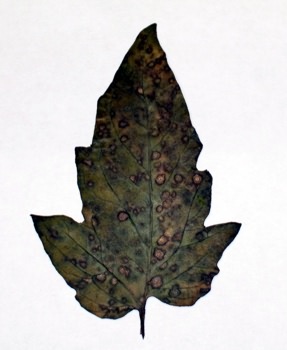Diseases
Septoria lycopersici Speg. - Septoria Blight of Tomatoes
Systematic position.
Division Ascomycota, order Dothideales, family Dothideaceae, genus Septoria.Biological group.
Biotroph parasite.Morphology and biology.
Leaves mainly, sometimes petioles, stalks, and fruits are affected. Fine, 2-3 mm in diameter, dirty-white spots with dark-brown limb forms on the lower leaves. In the centre of spots pycnidia of the fungus are formed as fine dark dots. The spots frequently merge at strong development of the disease, covering the whole leaf plate. Then the spot spreads to middle and upper leaves (except for the top ones). The affected leaves grow brown, roll, dry up, and fall down. On fruits the spots appear, being similar to spots on leaves, but having sharper pronounced limb and lighter centre. Fungal mycelium spreads in plant tissue, forming on a surface of the affected organs brownish-black pycnidia, 100-160 microns in diameter. Conidia threadlike-cylindrica, l 32-130 x 1.5-3 microns, with indistinct septa. During summer the fungus gives several generations. Sprouts in hotbeds and plants in open ground are affected.Ecology.
Pycnospores in pycnidia are source of the infection, keeping in vegetation residues, in fruits and ground. The fungus develops at temperature 15-27.C (optimum is 20-25.C) and relative air humidity 77-94%. Incubation period lasts 8-14 days.Distribution.
Septoria Blight was registered for the first time in 1910 in Ukraine (Kharkov and Sumy Regions). Now the disease meets everywhere in areas of tomato cultivation, but being most harmful in areas with increased humidity. Strong affection of tomatoes is marked in Western and Eastern Siberia, in the Far East, Baltic States, Byelorussia, Ukraine, Volgograd Region, Transcaucasia, Mordovia, Mari El, Bashkortostan, Chechnya and Ingushetia (affection of plants reaches 36-100%).Economic significance.
Early drying and falling of leaves result in reduction of tomato yield by 30-50% in some years. Protective actionsinclude destruction of vegetation residues; deep autumn plowing after harvesting; crop rotation with replanting by tomatoes on a same place not earlier, than in 3 years; disinfection of ground in hotbeds; spraying of plants by fungicides after appearance of the disease; cultivation of resistant varieties.Related references.
Dolidze M.I. 1968. About distribution and dynamics of development of Septoria Blight of Tomatoes in Georgia. In: Nakhutsrishvili I.G., ed. Materials of 3rd Transcaucasian conference on spore plants. Tbilisi: Institute of botany AN GSSR, p. 179-182. (In Russian).Dunenko M.A., Belikova V.K. 1977. Septoria Blight of Tomatoes. Zashchita rastenii 7: 35-36. (In Russian).
Gorlenko M.V. 1980. Phytopathology. Leningrad: Kolos, 318 p. (In Russian).
Guseinova B.F. 1968. Review of the genus Septoria in Azerbaijan. In: Nakhutsrishvili I.G., ed. Materials of 3rd Transcaucasian conference on spore plants. Tbilisi: Institute of botany AN GSSR, p. 176-179. (In Russian).
Hawksworth D.L., Kirk P.M., Sutton B.C., Pegler D.M. 1995. Ainsworth & Bisby.s Dictionary of the fungi. CAB International. 616 p.
Koshnikovich V.I. 1972. Resistance of some varieties of tomato to Septoria lycopersici Speg. In Novosibirsk Region. In: Ivanova O.A., ed. Plant protection. Bulletin of Siberian research institute of chemicalization of agriculture. Iss. 1-2. Novosibirsk: VASKHNIL, Siberian branch, p. 63-70. (In Russian).
Osnitskaya E.A. 1968. Diseases of vegetables. In: Polyakov I.Ya., Chumakov A.E., eds. Pests and diseases distribution on agricultural crops in RSFSR in 1967 and the forecast of their appearance in 1968. Moscow: Rosselkhozizdat: 120-125. (In Russian)
Osnitskaya E.A. 1969. Diseases of vegetables. In: Polyakov I.Ya., Chumakov A.E., eds. Pests and diseases distribution on agricultural crops in RSFSR in 1968 and the forecast of their appearance in 1969. Moscow: Rosselkhozizdat: 137-144. (In Russian)
Osnitskaya E.A. 1970. Diseases of vegetables. In: Polyakov I.Ya., Minkevich I.I., eds. Pests and diseases distribution on agricultural crops in RSFSR in 1969 and the forecast of their appearance in 1970. Moscow: MSKH RSFSR, VIZR: 252-263. (In Russian)
Osnitskaya E.A. 1971. Diseases of vegetables. In: Polyakov I.Ya., Minkevich I.I., eds. Pests and diseases distribution on agricultural crops in RSFSR in 1970 and the forecast of their appearance in 1971. Moscow: MSKH RSFSR, VIZR: 187-198. (In Russian)
Parfilova M.E. 1949. Study of diseases of tomatoes in conditions of Lviv Region. In: Tret.yakova V.F., ed. Scientific notes. Lviv: Lviv SKHI. V. 2, p. 101-115. (In Russian).
Ragimov U.A. 1980. Diseases of tomatoes and control measures for the main ones in conditions of Kirovabad hothouse industrial complex. In: Gvritishvili M.N., ed. Materials of Transcaucasian Coordination meeting on plant protection (May 15-16, 1980). Tbilisi: NIIZR Gruz.SSR, p. 71-74. (In Russian).
Rodigin V.M. 1997. Symptomatic peculiarities of Septoria Blight of Tomatoes in Kharkiv Region. In: Samersova V.F., ed. Topical problems of phytovirology and plant protection. Materials of scientific conference devoted to 85-anniversary of prof. Anton Lavrent'evich Ambrosov (Priluki, June 16, 1997). Minsk: Ekaunt, p. 109-111. (In Russian).
Vlasova E.A., Farber V.V. 1985. Methods of estimation of resistance of tomatoes to Septoria Blight. In: Dorofeev V.F., ed. Immunity of cultural plants to diseases and pests. Collection of proceedings on applied botany, genetics, and selection. Leningrad: VASKHNIL, VIR, V. 92, p. 85-91. (In Russian).
Voronina A.A., Kireenkova A.E., Sivak L.A. 1971. Pests and diseases of vegetable cultures. In: Tikhonov O.I., ed. Pests and diseases distribution on agricultural crops in Krasnodar Territory in 1970 and the forecast of their appearance in 1971. Krasnodar: STAZR, p. 80-87. (In Russian).


